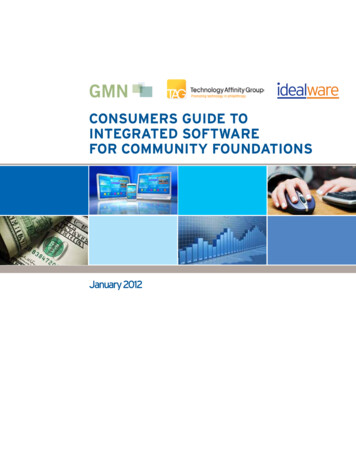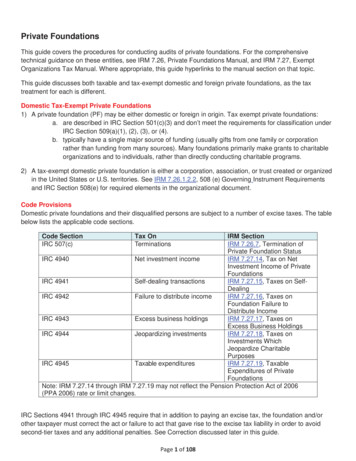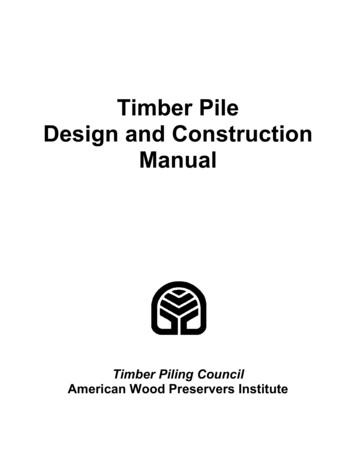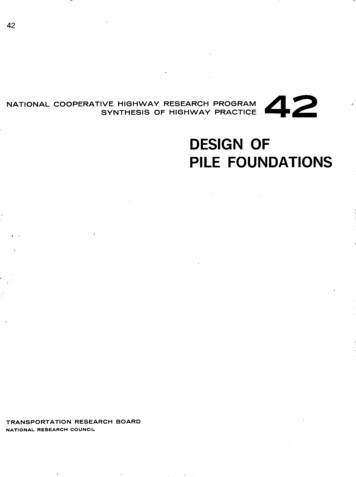
Transcription
42NATIONAL COOPERATIVE HIGHWAY RESEARCH PROGRAMSYNTHESIS OF HIGHWAY PRACTICE42DESIGN OFPILE FOUNDATIONSTRANSPORTATION RESEARCH BOARDNATIONAL RESEARCH COUNCIL
TRANSPORTATION RESEARCH BOARD 1977OfficersROBERT N. HUNTER, ChairmanSCHEFFER LANG, Vice ChairmanW. N. CAREY, JR., Executive DirectorExecutive CommitteeHENRIK E. STAFSETH, Executive Director, American Assn. of State Highway and Transportation Officials (ex officio)WILLIAM M. COX, Federal Highway Administrator, U.S. Department of Transportation (ex officio)RICHARD S. PAGE, Urban Mass Transportation Administrator, U.S. Department of Transportation (ex officio)JOHN M. SULLIVAN, Federal Railroad Administrator, U.S. Department of Transportation (ex officio)HARVEY BROOKS, Chairman, Commission on Sociotechnical Systems, National Research Council (ex officio)MILTON PIKARSKY, Chairman of the Board, Chicago Regional Transportation Authority (ex officio, Past Chairman 1975)HAROLD L. MICHAEL, School of Civil Engineering, Purdue University (ex officio, Past Chairman 1976)WARREN E. ALBERTS, Vice President (Systems Operations Services), United AirlinesGEORGE H. ANDREWS, Vice President (Transportation Marketing), Sverdrup and ParcelGRANT BASTIAN, State Highway Engineer, Nevada Department of HighwaysKURT W. BAUER, Executive Director, Southeastern Wisconsin Regional Planning CommissionMANUEL CARBALLO, Lecturer in Public Management, Harvard UniversityL. DEBERRY, Engineer-Director, Texas State Department of Highways and Public TransportationLOUIS J. GAMBACCINI, Vice President and General Manager, Port Authority Trans-Hudson CorporationHOWARD L. GAUTHIER, Professor of Geography, Ohio State UniversityFRANK C. HERRINGER, General Manager, San Francisco Bay Area Rapid Transit DistrictARTHUR J. HOLLAND, Mayor, City of Trenton, NJ.ANN R. HULL, Speaker Pro Tem, Maryland House of DelegatesROBERT N. HUNTER, Chief Engineer, Missouri State Highway DepartmentPETER G. KOLTNOW, President, Highway Users Federation for Safety and MobilityTHOMAS J. LAMPHIER, President, Transportation Division, Burlington Northern, Inc.A. SCHEFFER LANG, Assistant to the President, Association of American RailroadsDANIEL McFADDEN, Professor of Economics, University of CaliforniaROBERT S. MICHAEL, Director of Aviation, City and County of Denver, ColoradoTHOMAS D. MORELAND, Commissioner, Georgia Department of TransportationGEORGE E. PAKE, Vice President, Xerox Corp.; Manager, Xerox Palo Alto Research CenterDOUGLAS N. SCHNEIDER, JR., Director, District of Columbia Department of TransportationWILLIAM K. SMITH, Vice President (Transportation), General MillsNATIONAL COOPERATIVE HIGHWAY RESEARCH PROGRAMTransportation Research Board Executive CommitteeSubcommittee for the NCHRPROBERT N. HUNTER, Missouri State Highway Department (Chairman)A. SCHEFFER LANG, Association of American RailroadsHENRIK E. STAFSETH, Amer. Assn. of State Hwy. and Transp. OfficialsWILLIAM M. COX, U.S. Department of TransportationHARVEY BROOKS, National Research CouncilHAROLD L. MICHAEL, Purdue UniversityTopic Panel on Pile FoundationsW. N. CAREY, JR., Transportation Research BoardProject Committee SP 20-5RAY R. BIEGE, JR., Kansas Dept. of Transportation (Chairman)VERDI ADAM, Louisiana Department of HighwaysJACK FREIDENRICH, New Jersey Department of TransportationDAVID GEDNEY, Federal Highway AdministrationEDWARD J. HEINEN, Minnesota Department of HighwaysBRYANT MATHER, USAE Waterways Experiment StationTHOMAS H. MAY, Pennsylvania Department of TransportationTHEODORE F. MORF, ConsultantEDWARD A. MUELLER, Jack.vonville Transportation AuthorityREX C. LEATHERS, Federal Highway AdministrationROY C. EDGERTON, Transportation Research BoardBERNARD E. BurLER, New York State Dept. of TransportationDAVID S. GEDNEY, Federal Highway AdministrationBERNARD A. GRAND, Slattery AssociatesDAVID HUVAL, Louisiana Department of HighwaysPHILIP KEENE, ConsultantWENDEL T. RUFF, Mississippi State Highway DepartmentJ. W. GUINNEE, Transportation Research BoardL. F. SPAINE, Transportation Research BoardConsultant to Topic PanelALEKSANDAR S. VESK, J. A. Jones Professor and Dean,School of Engineering, Duke UniversityProgram StaffKRIEGER W. HENDERSON, JR., Program DirectorDAVID K. WITHEFORD, Assistant Program DirectorLOUIS M. MAcGREGOR, Administrative EngineerR. IAN KINGHAM, Projects EngineerROBERT J. REILLY, Projects EngineerHARRY A. SMITH, Projects EngineerROBERT E. SPICHER, Projects EngineerHERBERT P. ORLAND, EditorPATRICIA A. PETERS, Associate EditorEDYTHE T. CRUMP, Assistant Editor
NATIONAL COOPERATIVE HIGHWAY RESEARCH PROGRAMSYNTHESIS OF HIGHWAY PRACTICE42DESIGN OFPILE FOUNDATIONSALEKSANDAR S. VESIDUKE UNIVERSITYDURHAM, NORTH CAROLINARESEARCH SPONSORED BY THE AMERICANASSOCIATION OF STATE HIGHWAY ANDTRANSPORTATION OFFICIALS IN COOPERATIONWITH THE FEDERAL HIGHWAY ADMINISTRATIONAREAS OF INTEREST:BRIDGE DESIGNCONSTRUCTIONFOUNDATIONS (SOILS)RAIL TRANSPORTTRANSPORTATION RESEARCH BOARDNATIONAL RESEARCH COUNCILWASHINGTON, D.C.1977
NATIONAL COOPERATIVE HIGHWAY RESEARCH PROGRAMSystematic, well-designed research provides the most effective approach to the solution of many problems facinghighway administrators and engineers. Often, highwayproblems are of local interest and can best be studied byhighway departments individually or in cooperation withtheir state universities and others. However, the accelerating growth of highway transportation develops increasinglycomplex problems of wide interest to highway authorities.These problems are best studied through a coordinatedprogram of cooperative research.In recognition of these needs, the highway administratorsof the American Association of State Highway and Transportation Officials initiated in 1962 an objective nationalhighway research program employing modern scientifictechniques. This program is supported on a continuingbasis by funds from participating member states of theAssociation and it receives the full cooperation and support of the Federal Highway Administration, United StatesDepartment of Transportation.The Transportation Research Board of the National Research Council was requested by the Association to administer the research program because of the Board's recognized objectivity and understanding of modern researchpractices. The Board is uniquely suited for this purposeas: it maintains an extensive committee structure fromwhich authorities on any highway transportation subjectmay be drawn; it possesses avenues of communications andcooperation with federal, state, and local governmentalagencies, universities, and industry; its relationship to itsparent organization, the National Academy of Sciences, aprivate, nonprofit institution, is an insurance of objectivity;it maintains a full-time research correlation staff of specialists in highway transportation matters to bring the findingsof research directly to those who are in a position to usethem.The program is developed on the basis of research needsidentified by chief administrators of the highway and transportation departments and by committees of AASHTO.Each year, specific areas of research needs to be includedin the program are proposed to the Academy and the Boardby the American Association of State Highway and Transportation Officials. Research projects to fulfill these needsare defined by the Board, and qualified research agenciesare selected from those that have submitted proposals. Administration and surveillance of research contracts areresponsibilities of the Academy and its TransportationResearch Board.The needs for highway research are many, and the NationalCooperative Highway Research Program can make significant contributions to the solution of highway transportationproblems of mutual concern to many responsible groups.The program, however, is intended to complement ratherthan to substitute for or duplicate other highway researchprograms.NCHRP Synthesis 42Project 20-5 FY '73 (Topic 5-04)ISBN 0-309-02544-3L. C. Catalog Card No. 77-90474Price: 4.80NoticeThe project that is the subject of this report was a part of theNational Cooperative Highway Research Program conducted by theTransportation Research Board with the approval of the GoverningBoard of the National Research Council, acting in behalf of theNational Academy of Sciences. Such approval reflects the GoverningBoard's judgment that the program concerned is of national importance and appropriate with respect to both the purposes and resources of the National Research Council.The members of the technical committee selected to monitor thisproject and to review this report were chosen for recognizedscholarly competence and with due consideration for the balanceof disciplines appropriate to the project. The opinions and conclusions expressed or implied are those of the research agency thatperformed the research, and, while they have been accepted asappropriate by the technical committee, they are not necessarily thoseof the Transportation Research Board, the National Research Council, the National Academy of Sciences, or the program sponsors.Each report is reviewed and processed according to proceduresestablished and monitored by the Report Review Committee of theNational Academy of Sciences. Distribution of the report is approved by the President of the Academy upon satisfactory completion of the review process.The National Research Council is the principal operating agency ofthe National Academy of Sciences and the National Academy ofEngineering, serving government and other organizations. TheTransportation Research Board evolved from the 54-year-old Highway Research Board. The TRB incorporates all former HRBactivities but also performs additional functions under a broaderscope involving all modes of transportation and the interactions oftransportation with society.Published reports of theNATIONAL COOPERATIVE HIGHWAY RESEARCH PROGRAMare available from:Transportation Research BoardNational Academy of Sciences2101 Constitution Avenue, N.W.Washington, D.C. 20418Printed in the United States of America.
PREFACEThere exists a vast storehouse of information relating to nearly every subject ofconcern to highway administrators and engineers. Much of it resulted from researchand much from successful application of the engineering ideas of men faced withproblems in their day-to-day work. Because there has been a lack of systematicmeans for bringing such useful information together and making it available to theentire highway fraternity, the American Association of State Highway and Transportation Officials has, through the mechanism of the National Cooperative HighwayResearch Program, authorized the Transportation Research Board to undertake acontinuing project to search out and synthesize the useful knowledge from all possible sources and to prepare documented reports on current practices in the subjectareas of concern.This synthesis series attempts to report on the various practices, making specific recommendations where appropriate but without the detailed directions usuallyfound in handbooks or design manuals. Nonetheless, these documents can servesimilar purposes, for each is a compendium of the best knowledge available onthose measures found to be the most successful in resolving specific problems. Theextent to which they are utilized in this fashion will quite logically be tempered bythe breadth of the user's knowledge in the particular problem area.FOREWORDThis synthesis will be of special interest and usefulness to bridge engineers andothers seeking information on pile foundations. Detailed information is presentedon pile design principles and criteria.By StafjTransportationResearch BoardAdministrators, engineers, and researchers are faced continually with manyhighway problems on which much information already exists either in documentedform or in terms of undocumented experience and practice. Unfortunately, thisinformation often is fragmented, scattered, and unevaluated. As a consequence,full information on what has been learned about a problem frequently is notassembled in seeking a solution. Costly research findings may go unused, valuableexperience may be overlooked, and due consideration may not be given to recommended practices for solving or.alleviating the problem. In an effort to correct thissituation, a continuing NCHRP project, carried out by the Transportation ResearchBoard as the research agency, has the objective of synthesizing and reporting oncommon highway problems. Syntheses from this endeavor constitute an NCHRPreport series that collects and assembles the various forms of information into single
concise documents pertaining to specific highway problems or sets of closely relatedproblems.Pile foundations are used by all state highway agencies and by other organizations involved in civil engineering projects. However, present procedures for designvary considerably among agencies and in some cases do not reflect the best availableinformation. This report of the Transportation Research Board reviews designprinciples and construction problems and recommends criteria based on currentknowledge.To develop this synthesis in a comprehensive manner and to ensure inclusionof significant knowledge, the Board analyzed available information assembled fromnumerous sources, including a large number of state highway and transportationdepartments. A topic panel of experts in the subject area was established to guidethe researchers in organizing and evaluating the collected data, and to review thefinal synthesis report.This synthesis is an immediately useful document that records practices thatwere acceptable within the limitations of the knowledge available at the time of itspreparation. As the processes of advancement continue, new knowledge can beexpected to be added to that now at hand.
CONTENTS1SUMMARYPART IIntroductionEstablishment of Need for a Pile FoundationSelection of Pile TypeNotations and Definitions3CHAPTER ONE8CHAPTER TWODesign CriteriaBasic Design ConsiderationsThe Ultimate-Load CriterionComputation of the Ultimate LoadPile ResistancePoint ResistanceSkin ResistanceDetermination of Point and Skin Resistances from FieldTestsSummary of Recommendations for Design12CHAPTER THREE22CHAPTER FOUR31CHAPTER FIVE33CHAPTER36CHAPTER SEVEN44CHAPTER EIGHT55REFERENCESPile-Soil InteractionLoad TransferNegative Skin FrictionAnalysis of Load TransferSettlement Analysissix Pile GroupsLateral LoadingSingle Pile Under Lateral LoadsPiles Subjected to Lateral Soil MovementAxial Capacity of Initially Bent PilesPile BucklingPile Groups Under Eccentric and Inclined LoadsConstruction ProblemsDynamics of Pile DrivingLoad Testing of PilesAuthor IndexPART II65APPENDIX AAnalysis of Point Resistance
FIGURES489111111131314Figure 1.Figure 2.Figure 3.Figure 4.Figure 5.Figure 6.Figure 7.Figure 8.Figure 9.141516171819202021Figure 10.Figure 11.Figure 12.Figure 13.Figure 14.Figure 15.Figure 16.Figure 17.Figure 18.222323Figure 19.Figure 20.Figure 21.2324242526Figure 22.Figure 23:Figure 24.Figure 25.Figure 26.27272829303031,Figure 27.Figure 28.Figure 29.Figure 30.Figure 31.Figure 32.Figure 33.3434353638383939404041414243,4344474848Figure 34.Figure 35.Figure 36.Figure 37.Figure 38.Figure 39.Figure 40.Figure 41.Figure 42.Figure 43.Figure 44.Figure 45.Figure 46.Figure 47.Figure 48.Figure 49.Figure 50.Figure 51.Figure 52.495050515253545455Figure 53.Figure 54.Figure 55.Figure 56.Figure 57.Figure 58.Figure 59.Figure 60.Figure 61.Situations in which piles may be needed.Failure pattern under a model pile in soft dày.Load-displacement diagrams for series of test piles in sand.Load-displacement diagram of a test pile drawn in two different scales.Basic problem of a deep foundation.Effects of placement of pile into a soil mass.Assumed failure pattern under pile point.Failure patterns under pile point in dense sand.The shape of wedge, variations of sand density, and displacement pattern under the tip of a20-cm pile in dense sand.Variation of bearing capacity factor N. with L and 0.Experimental values of Nq* in sand from different investigations.Comparison between skin resistance of piles in clay and undrained strength.Field data on increase of bearing capacity with time for friction piles in clay.Observed values of skin bearing capacity factor N. in normally consolidated clays.Observed values of N. for bored piles in London clay.Observed values of N. for driven piles in stiff, overconsolidated clays.Variation of skin resistance of piles in sand with relative density.Evaluation of point resistance of 18-in. (450-mm)-diameter pile from results of static-penetration test.Transfer factor X q0/P0 for cohesionlèss soils.Mobilization of base and shaft resistance as a function of pile displacement.Relative magnitude of point loads at various stages of loading of closed-end pipe piles in densesand.Load transfer from a steel pile driven through compressible silt to rock.Load transfer from tubular-steel piles in stiff clay.Effect of residual loads on load distribution in driven piles in sand at Arkansas River.Measured distributions of skin resistance.Axial load developed by negative skin friction in. open-end and closed-end pipes in silt, endingin dense sand.Load transfer from a single pile.Typical simple distributions of skin resistance.Load-transfer analysis: (a) elastic-solid approach and (b) transfer-function approach.Distribution of vertical stresses around a pile in elastic solid.Finite-element analysis of load transfer.Deformation models used in load-transfer analysis.Computed distribution of skin friction for Arkansas River site piles loaded in cyclic compression.Typical configurations of pile groups.Observed efficiencies of square pile groups in sand.Effect of driving sequence on efficiency of piles in loose sand.Single pile under the action of lateral loads.Variation of coefficient of subgrade reaction (its) for piles in sand.Variation of coefficient of subgrade reaction (nh) for piles in clay.Increase of deflection of laterally loaded piles under cyclic loading.Piles subjected to lateral movement of soil.Basic problem of a pile subjected to lateral soil movement.Buckling of partially embedded piles.Examples of structural systems with batter piles.Problem of a pile foundation subjected to eccentric and inclined loads.Definition of pile coefficients.Sign convention for p and q.Group of vertical piles subjected to eccentric and inclined loads.Principle of operation of pile drivers.Problem of pile driving.Rheological model of soil resistance at pile-soil interface.Relationship between peak driving force and pile impedance for Vulcan SA hammers. Shadedarea indicates conditions of maximum transmission of driving energy.Discrete-element model of the pile-soil system.Typical result of wave-equation analysis of driving stresses.Typical result of wave-equation analysis of pile resistance.Typical setup for pile load testing in axial compression using anchor piles.Typical setup for pile load testing in axial compression using a loading platform.Typical setup for measurement of pile displacements.Typical setup for pile load testing in tension using direct jacking with straps.Typical setup for pile load testing in tension using cross-beams.Typical setup for lateral load tests.
TABLES51016282933454646486668Table 1.Table 2.Table 3.Table 4.Table 5.Table 6.Table 7.Table 8.Table 9.Table 10.Table A-i.Table A-2.Principal Advantages and Disadvantages of Different Pile Types.Rules for Determination of Ultimate Load.Experimental Values of Nq* in Sand.Methods of Load Transfer Analysis by Transfer Function Approach.Method of Load Transfer Analysis by Elastic Solid Approach.Typical Values of Coefficients C.Impact Pile-Driver Data.Comparison of Vibratory Drivers.Typical Pile Cushion Material Properties.Stress-Transmission Characteristics of Typical Piles.Bearing Capacity Factors for Deep Foundations.Typical Values of Rigidity Index, Ir.
ACKNOWLEDGMENTSThis synthesis was completed by the Transportation ResearchBoard under the supervision of Paul E. Irick, Assistant Director for Special Projects. The Principal Investigators responsible for conduct of the synthesis were Thomas L. Copas andHerbert A. Pennock, Special Projects Engineers. This synthesis was edited by Deborah K. Farmer.Special appreciation is expressed to Dr. Aleksandar S. Vesi6,J. A. Jones Professor and Dean, School of Engineering, DukeUniversity, who was responsible for the collection of data andpreparation of the report.Valuable assistance in the preparation of this synthesis wasprovided by the Topic Panel, consisting of Bernard E. Butler,Associate Soils Engineer, New York State Department ofTransportation; David S. Gedney, Director, Northeast CorridorAssistance Project, Federal Highway Administration; BernardA. Grand, Chief Design Engineer, Slattery Associates, Maspeth,N. Y., David Huval, Bridge Design Engineer, Louisiana Department of Highways; Philip Keene, Consultant, Middletown,Conn.; Wendel T. Ruff, Chief Soils Engineer, Mississippi StateHighway Department.John W. Guinnee, Engineer of Soils, and Lawrence F. Spaine,Engineer of Design, Transportation Research Board, assistedthe Special Projects staff and the Topic Panel.
DESIGN OFPILE FOUNDATIONSSUMMARYThe first problem facing the designer of a foundation is to determine whether ornot the site conditions are such that piles must be used. Piles are used whereupper soil strata are compressible or weak; where footings cannot transmit inclined,horizontal, or uplift forces; where scour is likely to occur; where future excavationmay be adjacent to the structure; and where expansive or collapsible soils extendfor a considerable depth.Piles may be classified by material type or by method of placement. The choiceof pile type is influenced by subsurface conditions, location and topography of thesite, and structural and geometric characteristics of the structure to be supported.The designer of a deep foundation must possess a variety of skills, much experience, and considerable knowledge of engineering sciences. No set of simple rulesand procedures can be expected to cover the variety of conditions and forms ofinstability that can endanger a deep foundation.The ultimate load on a pile is the load that can cause failure of either the pileor the soil. The pile failure condition may govern design where pile points penetrate dense sand or rock, but in most situations, ultimate load is determined by thesoil failure. The soil always fails in the same manner: punching shear under thepoint, accompanied or preceded by direct-shear failure along the shaft. Becausethe ultimate load is often not well defined, various empirical ultimate load criteriahave to be used. Most often these have been based on considerations of plastic(irrecoverable) or total (plastic and elastic) settlements of the pile under a testload. Unless the load-settlement curve shows a definite peak load, the most acceptable criterion would define the ultimate load as that causing total pile settlementequal to 10 percent of the point diameter for driven piles and 25 percent for boredpiles.Computation of the ultimate load is quite difficult and a "general solution" isnot yet available. For design purposes, the ultimate load is separated into twocomponents: the base or point load, and the shaft or skin load. Theories for determination of point load based on the plasticity theory are now considered inadequateand are being replaced by linear or nonlinear elasto-plastic theories. The theoreticalapproach for evaluation of skin resistance is similar to that used to analyze resistanceto sliding of a rigid body in contact with the soil. Equations are available to calculate the point and skin resistances. However, the calculations require detailedknowledge of strength and deformation characteristics of the soil strata and also ofthe variation of density and water content within those strata. For most structures,the cost of obtaining this information is prohibitive; in addition, it is normallypreferable to estimate unit resistance directly from such field tests as the static-conepenetration test, standard penetration test, or pressuremeter test.The displacement needed to mobilize skin resistance is small compared to thatfor point resistance. Thus, ultimate skin resistance is reached much sooner thanpoint resistance and the portion of the load carried by the point is smaller in working conditions than at failure.In situations where soil around a pile moves downward (e.g., because of waterremoval from aquifer strata), it exerts a negative friction (downdrag) on the pile
2and may cause severe damage to the structure. Several methods are available to reduce negative skin friction, including installing piles in casing or coating them withbitumen.The mechanics of load transfer between pile and soil is very complex. Someparameters are difficult to express in numerical terms. Yet numerical assessment isessential, and several analytical methods are available, based either on a transferfunction approach or an elastic-solid approach.Settlement analysis of pile foundations is somewhat similar to that of shallowfoundations. However, there are differences because the soil has been disturbed bypile placement and thus may exhibit sharp variations of stiffness. Furthermore, adriven pile may retain residual stresses, the exact position of load transfer to thesoil is unknown, and adjacent piles may have an effect. Thus, only approximatesolutions to pile settlement are available.Pile foundations are normally constructed as groups of closely spaced piles.Pile spacing is based on stability and economy; ideally, the spacing should be suchthat the group capacity is not less than the sum of the capacities of the individualpiles. However, this is not always possible. The ultimate load of a group may beless than the sum depending on soil type, size and shape of the group, spacing andlength of piles, and construction procedures. In addition, settlement of a group isusually more than that of a single pile with comparable working load. There is currently no acceptable rational theory for the bearing capacity of groups. A numberof empirical "efficiency formulae" have been used, as well as other methods. However, current knowledge of the factors affecting bearing capacity and settlement ofpile groups is limited and research is needed for safe, economical design.When a pile is required to transmit lateral loads into the ground, it is necessaryto determine lateral deflection, slope of the pile axis, and position and magnitudeof maximum bending moment. If certain assumptions are made, the solutions arerelatively simple and reasonably accurate.Horizontal movements of the ground can cause a dangerous lateral loading onpiles that can be large enough to break a pile in bending or shear. Piles in areaswhere this type of loading can occur must be designed with a sufficient safety factorto prevent failure.Buckling of fully embedded piles is rare as long as the soil is capable of supporting a pile in friction. Partially embedded piles may be analyzed to determinethe buckling load.Horizontal loads on pile groups may require that some piles be battered toavoid excessive movement of the foundation or bending in the piles. Design solutions are available that show a reasonable agreement with observed behavior.Pile driving is most commonly done by impact hammers wherein a ram fallsor is driven repeatedly against the pile head. Vibratory drivers are also used. Atthe driving site the engineer needs to know whether a pile can be driven with agiven hammer; if so, what is the set in the final blows, what is the maximum stressin the pile, and should a hard or soft cushion be used? To answer these questions,a rational analysis may be useful. Computations show that both compressive andtensile stresses in piles can be reduced by using a heavier ram with lower impactvelocity. The stresses can also be reduced by the use of cushions. The waveequation approach, despite some shortcomings, is superior to the conventional"pile-formula" approach, although the latter may work well for many sites.Because of the many uncertainties in analysis of pile foundations, it has become customary to perform full-scale pile load tests at the site of important projectsto verify actual pile response to load. Various arrangements are used to load thetest pile, all incorporating a hydraulic jack to transmit the load and gauges to mea-
sure movement. A strain rod arrangement built into the test pile allows measurement of settlement at points along the pile. Two principal methods of loading areused. In the load-controlled mode, the load is applied in increments of the designload and maintained until settlements cease. In the displacement-controlled mode,small increments of settlement are imposed and maintained until the load reachesequilibrium. In a variation of the latter mode settlement, increments are imposed atspecified time intervals. Load testing can not be used as a substitute for an engineering analysis of anticipated performance under load. Such an analysis should bebased on the principles outlined in this synthesis and must include an adequate soilexploration and testing program.CHAPTER ONEINTRODUCTIONESTABLISHMENT OF NEED FOR A PILE FOUNDATIONThe first difficult problem confronting the designer of afoundation is to establish whether or not the site conditionsare such that piles must be used. Principal situations inwhich piles may be needed are shown in Figure 1. The mostcommon case is that in which the upper soil strata are toocompressible or generally too weak to support heavy vertical reactions transmitted by the superstructure. In thisinstance, piles serve as extensions of columns or piers tocarry the loads to a deep, rigid stratum such as rock (pointbearing piles, Fig la). If such a rigid stratum does notexist within a reasonable depth, the loads must be graduallytransferred, mainly by friction, along pile shafts (frictionpiles, Fig. ib).Piles
Engineering, serving government and other organizations. The Transportation Research Board evolved from the 54-year-old High-way Research Board. The TRB incorporates all former HRB activities but also performs additional functions under a broader scope involving all modes of transporta
![Pile Foundation Design[1] - ITD](/img/29/pilefoundationdesign.jpg)
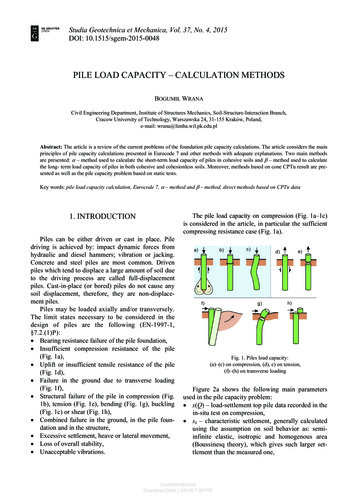
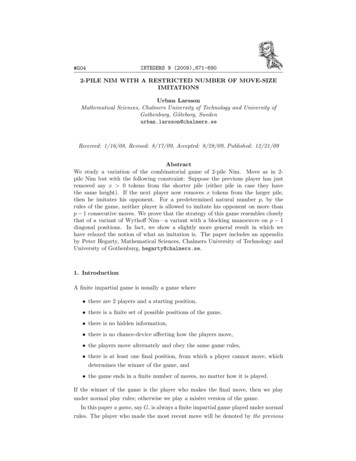
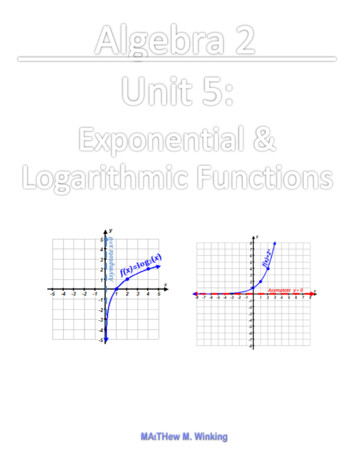
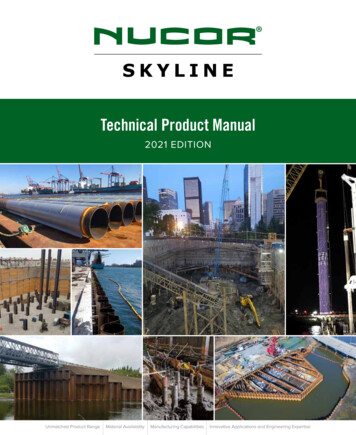
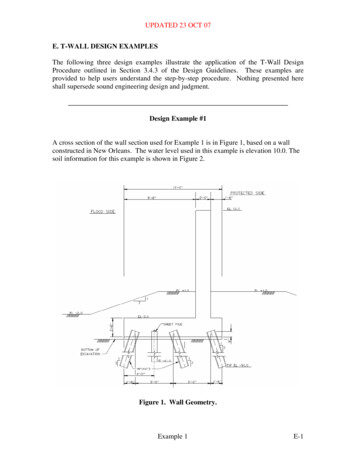

![20160924 修正版 System Keisoku ENG.ppt [互換モード]](/img/4/companyprofileinenglish.jpg)
